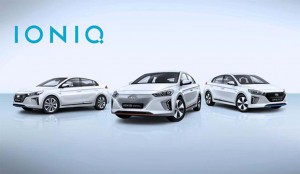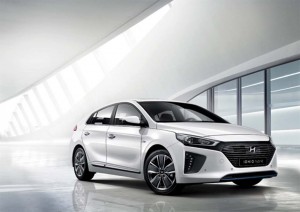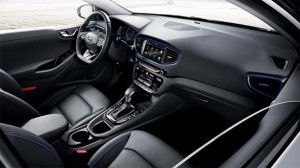When it comes to taking on the ever-popular Toyota Prius, Hyundai is pulling off the gloves.
Like Prius, the new Hyundai Ioniq that debuted today at the Geneva Motor Show also features its own, unique body, something that the Korean carmaker hopes will let it stand out from more traditional compact models. But unlike Toyota’s hybrid, the Ioniq will be offered in three distinctive “flavors,” a conventional hybrid, a plug-in and a pure battery-electric version, as well.
“We are bringing a unique new approach to e-mobility,” said Jochen Sengpiehl, Vice President Marketing at Hyundai Motor Europe, “with no compromise on great design, driving pleasure and new connectivity features. And we’re making it accessible to more customers, further extending our product line-up.”
(Live from Geneva: Click Here for complete coverage.)
Hyundai hopes to reach even further, officials noted, with the new battery-based model serving as the foundation of a new research program dubbed Project Ioniq. The goal is to come up with “innovative products and services.” That will touch on such high-tech topics as autonomous driving and connected vehicles.
But, initially, the focus will be on environmentally friendly powertrain technology. And buyers will have three different options to choose from:
- The Ioniq Hybrid is powered by a 104 horsepower 1.6-liter GDI engine paired with a 32 kW, or 43 hp, electric motor linked to a 1.56 kWh lithium battery. Hyundai claims the Kappa engine was specifically tailored to this application, with a diesel-like 40% thermal efficiency. The combination turns out 139 horsepower through a six-speed double-clutch gearbox. Top speed is about 115 mph;
- The Ioniq Plug-In uses the same Kappa gas engine but bumps the lithium battery up to 8.9 kilowatt-hours. The electric motor is also larger, at around 63 horsepower. The Plug-In is expected to get about 31 miles of range per charge. The package cuts CO2 emissions by more than half compared to the Hybrid, to as low as 32 grams per kilometer;
- The Ioniq Electric relies on a 28 kWh lithium-polymer battery and is expected to deliver up to 250 kilometers – or 155 miles – range per charge, though that’s on the European test cycle and would likely be lower in the U.S. The electric motor makes 118 horsepower and 218 lb-ft of torque. Top speed is rated at 103 mph.
“With our pioneering ix35 Fuel Cell electric vehicle and several hybrid and plug-in hybrid models sold around the world,” says Thomas A. Schmid, Chief Operating Officer at Hyundai Motor Europe, “Hyundai Motor already has a proven capability in electrified powertrains. Now, with the launch of our first dedicated model, we are taking the lead as the only car manufacturer with hybrid, electric, plug-in hybrid and fuel cell vehicles in production.”
(Honda unveils Civic Hatchback in Geneva. Click Here to get a closer look.)
The high-tech concept carries over to the passenger compartment, all three versions of the Hyundai Ioniq offered with Android Auto, Apple CarPlay, and TomTom navigation and other live services. Atop the center stack, it all comes together through a 7-inch touchscreen display.
Safety features include Autonomous Emergency Braking, Lane Keep Assist System, Blind Spot Detection, Rear Cross Traffic Alert and Smart Cruise Control.
Hyundai claims the Ioniq has one of the best aerodynamic designs on the market, with a drag coefficient of just 0.24. It has also targeted mass by using lightweight materials such aluminum for the hood and tailgate.
As for the longer-term Project Ioniq, “The future mobility lifestyles that we envisage is about staying connected to our daily lives all the time without being bound by the limitations of time and space,” said Euisun Chung, Vice Chairman of Hyundai Motor. “We are determined to make this a reality so that everyone can enjoy better, more fulfilling lives.”
Chung said the carmaker will focus on three main areas: predicting changes in future mobility; creating new types of mobility to adapt to changing social needs and desires; and creating “new service models and mobility experiences that extend the role and definition of ‘cars.’”
(Bugatti rolls out 261 mph Chiron in Geneva. Click Here to catch it.)



